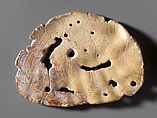Pendant with Figure and Double-Headed Crocodilian
Not on view
The main subject of this pendant is a human figure in a dynamic pose atop a large bicephalic reptilian creature. The artist carved this openwork and incised image in one half of a ridged bivalve that retains its undulating surface. Carefully drilled sections of negative space delineate the figure’s feet, legs, arms, and head. Two holes also pierce the tip of each reptilian head. Two smaller holes at the top of the composition may have been used to suspend the shell from a cord or affix it to a garment. Remains of red pigment in some of the incised lines may indicate that this was once part of a funerary assemblage, as descendants often coated their ancestors’ remains with red pigment upon burial.
Maya artists represented both the sky and the surface of the earth as large, two-headed, crocodilian creatures. The larger head, to the viewer’s left, consists of the upper jaw and head flaring up to frame the human figure’s face. The large eye with spiral pupil lies below a trefoil eyebrow, a convention to denote that this is probably a sky crocodile (the terrestrial crocodile’s eyes are generally marked with crossed-bands). Large teeth protrude from the long snout, marking the edge of the shell. The body of the creature passes behind the human figure, arching up over his outstretched hand. The second head, protruding from a round shield composed of concentric circles, faces upward, also marked by a spiral pupil, as the mouth opens towards the human figure’s headdress.
The figure faces left, and wears a loincloth, beaded necklace, pendant ear flares and tall headdress which has a profile face on its upper section. He is actively posed with his left arm outstretched and right arm bent towards his chest, while is right leg is crossed behind his left. This pose may hint that the person is a ballplayer, as these types of leaning, crossed-leg poses sometimes appear in ballgame scenes. It also may denote floating, in the form of an ancestor, given that Maya artists also depicted deceased forebearers as floating entities in other contexts. The floating interpretation accords with the identification of the second being as the crocodilian creature of the sky.
Shell was a highly prized luxury material in ancient Maya culture. It had symbolic meaning for its association with water and the sea and, by extension, fertility and the underworld. It was used to produce various types of personal ornaments for individuals of high rank.
Further reading
Juárez Cossío, Daniel, Adrián Velásquez Castro, and Norma Valentín Maldonado El joven Dios del maíz. Tecnología y simbolismo de un pendiente de concha del Museo Nacional de Antropología. Estudios de Cultura Maya 47(1): 31-53, 2016.
Velásquez Castro, Adrián, Pre-Columbian Maya Shell objects: An Analysis of Manufacturing Techniques. In Ancient Maya Art at Dumbarton Oaks, edited by Joanne Pillsbury, Miriam Doutriaux, Reiko Ishihara-Brito, and Alexandre Tokovinine, Washington DC: Dumbarton Oaks, 2012, pp. 440-474.
Velásquez Castro, Adrián, Luxuries from the Sea: The Use of Shells in the Ancient Americas. In Pillsbury, Joanne, Timothy F. Potts, and Kim N. Richter, eds. Golden Kingdoms: Luxury Arts in the Ancient Americas. Los Angeles: J. Paul Getty Museum, 2017, pp. 91-98.
Due to rights restrictions, this image cannot be enlarged, viewed at full screen, or downloaded.
This artwork is meant to be viewed from right to left. Scroll left to view more.



